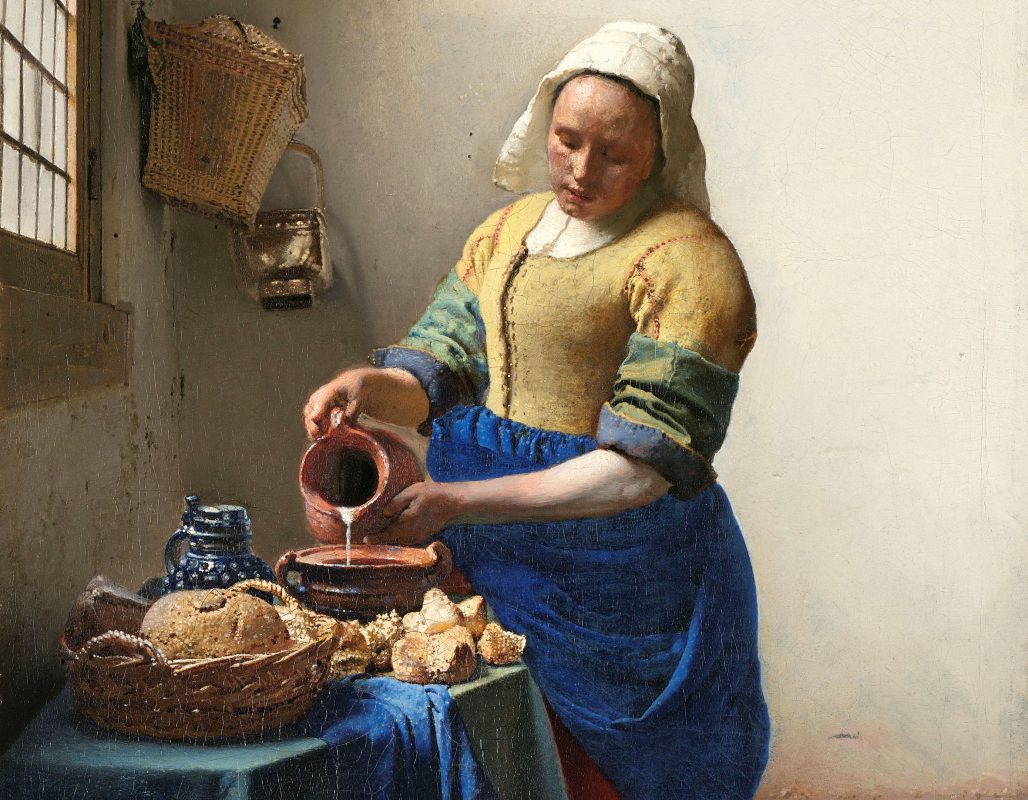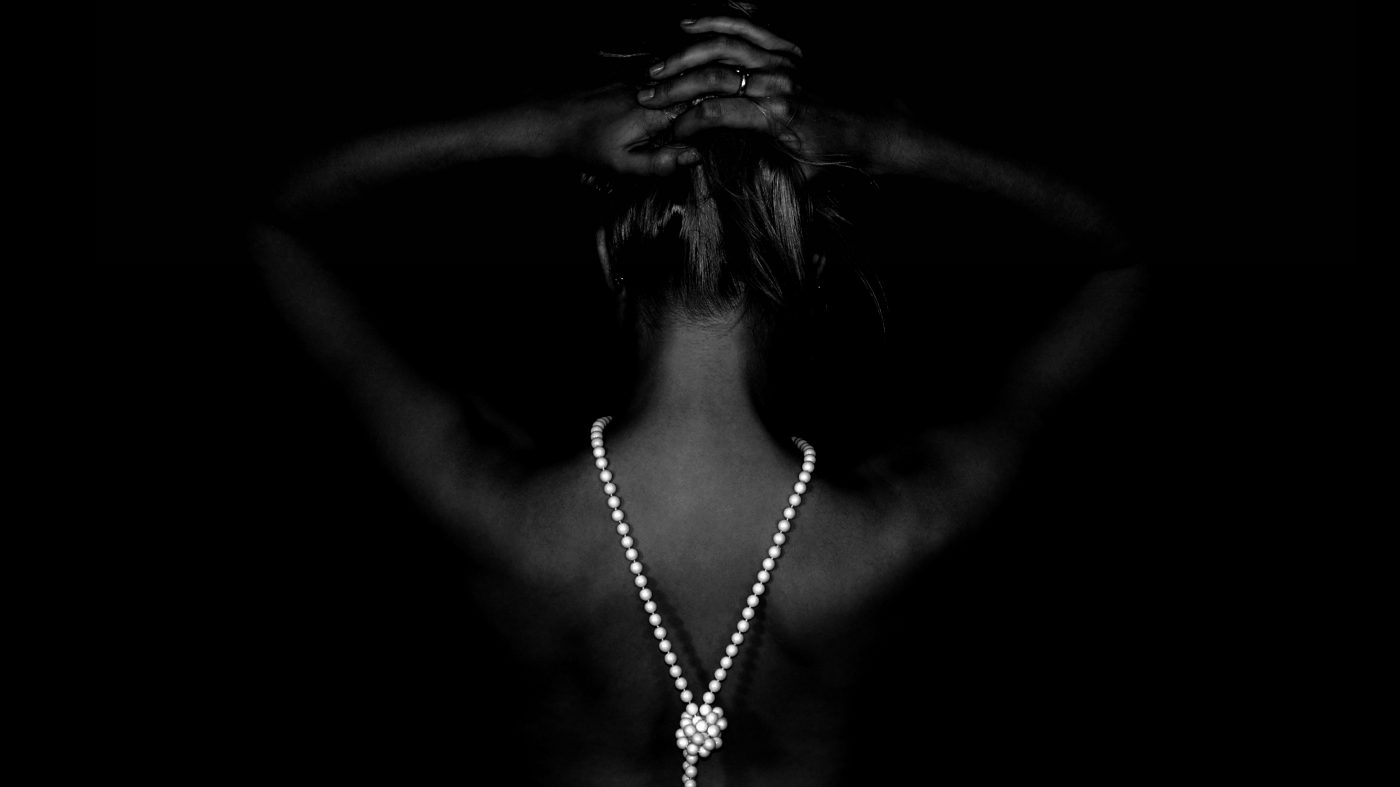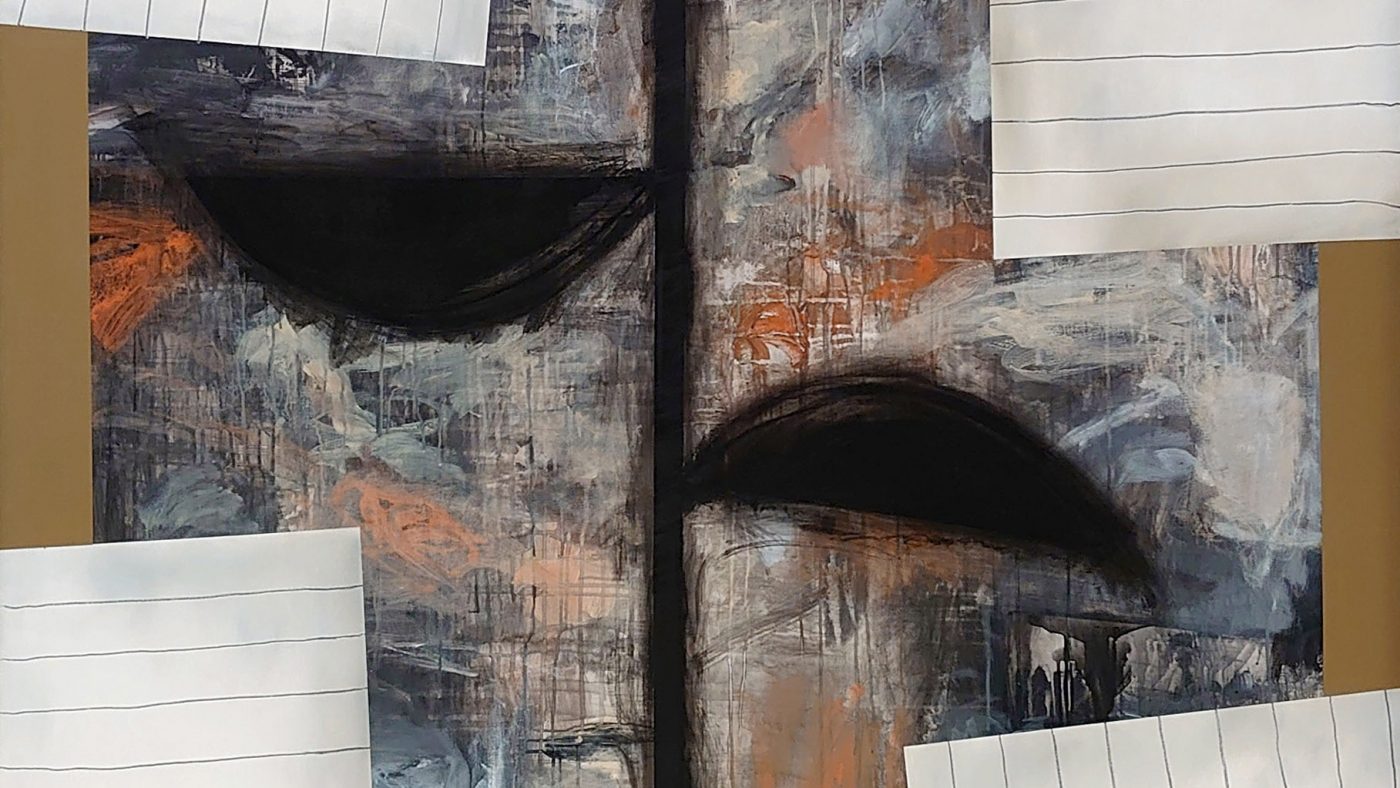The beauty of simplicity
An enamelled ceramic vessel takes up the centre of the stage. Small at first glance, it exhibits the luminosity of its tones. It settles on a dark, smooth horizontal surface, probably a tabletop, a kitchen counter or, due to its thickness, even the cornice of a fireplace. The association of both elements causes a very pronounced contrast. This painting by Mateusz Wysiecki denotes exceptional realism and provokes an approach for an intimate, sincere and non-shrill dialogue. That whisper, tuneful and soft, orchestrates the return to the essence of things, to classicism in terms of modernity where the astonishing and, sometimes unnoticed, beauty of simplicity appears.
The framing offers an interior with natural light because of the proximity of a window. The illumination bursts from the left edge almost frontally. Its neutrality and diffusion allude to the foggy sky outside. Despite the size of the canvas and its supposed triviality, a reverberation stealthily blurs the contours. This resource, more common in landscape, increases the sensation of depth by highlighting the ethereal. Not in vain, the insinuation of an aerial perspective confers an enigmatic character upon the still life, even when the magnification happens in a strictly symbolic way. For all that, the luminous radiation infuses into the assemblage a latency with a dazzling halo of baroque mysticism. The profuse reflection between the concave piece and the background attenuates the nakedness that defines them, outlining an extremely subtle diagonal that subliminally bestows a very timid dynamism.
Within the terminology of technical drawing, the geometry of the glass is called the ‘solid of revolution.’ In practice, the pottery wheel allows the modelling to shape the clay by rotation before baking in two phases: for hardening the material and for glazing. Deepening this analogy, the location of the referent within space reminds one of the dihedral system. In this type of representation, plan and elevation emerge from the perpendicular projection with two intersecting planes at 90°. For this reason, the zenithal view of the motif would disclose the plan, while the elevation would concur with a frontal observation. The lateral plane becomes redundant because, on this occasion, the elevation and the profile coincide. In short, the mise-en-scène seems to stimulate a very thoughtful perception of this topic. Therefore, we foresee a profound study to proclaim a paradigm of universality. In this analytical effort, the horizontal and vertical planes describe the first quadrant of the coordinate axis.
The paradox emerges when the object enables a methodology in which it is not participating. The painting thus celebrates the achievement of the truth, surpassing the one that scientific rigour claims in its eagerness to constitute an unequivocal reality with three complementary drawings. Why? Because the artistic phenomenon addresses the complexity of three-dimensionality through intuitive thinking, capable of decoding and compressing it persuasively. In this exciting transition between the sensible and the ideal, the most magical and sagacious omission conquers the space.
Simultaneously, the oneiric identity stated by Horacio with his famous ut pictura poiesis (as painting is, so is poetry) arises. Indeed, the greatness of art resides in its ability to transcend the meaning of what inspires it. In Michel Foucault, we find a more recent review of the authenticity of mimesis. The French philosopher delves into René Magritte’s work to eloquently remark on the dilemma between sign and image, word and icon, reading and vision. Consequently, ‘this is not a vessel’ since Mateusz Wysiecki does not restrict himself to the mere staging of everyday life but rather exalts it with infinite nuances and underlying evocations.
Returning to the surface, the enamel crystallises when combining quartz with other fluxes. A brush or an airbrush gun applies it on the mass bisque. After its second move through the oven, it cools until it solidifies into an impermeable film. This finish extends its use to containing food or liquids, which should help to understand whether it is a kitchen utensil or a vase and, therefore, the appropriate room of the house for it. But the sobriety of the whole, devoid of any unnecessary aspects, opens up to this ambiguity in favour of the most flagrant minimalism. The opaque whitish tone also reveals a more or less homogeneous employment of tin oxide and, in turn, the original link to Islamic ceramics. The iconography shows three stripes that run horizontally across the piece from the mouth of the glass. This ornament, equivalent to two and a half times the total height of the bowl, introduces striking cuneiform motifs in its central part. This area is guarded, above and below, by alternating isosceles triangles and six tiny points that insist on verticality. Surprisingly, the vertices of all the triangles neglect symmetry and seek to compensate for the lower ornamental emptiness. The imperfect spelling of the signs, handwritten with copper oxide, depicts all that fantasy. This substance generates the orange metallic shine that linearly crowns the upper edge.
The choice of the point of view does not obey arbitrariness. Instead, it equates the narrative of the figure with a single image. This circumstance forces a projective contraction to circumscribe the circle of the plan. The effect of perspective causes a foreshortening that modifies the proportions of the circumference until it becomes a magnificently elaborate ellipse. Something similar happens with the horizontal plane, which detaches itself from its true magnitude, showing the consequent fading of the most distant edge. In addition to the already mentioned depth and luminosity, this photographic blur contains a new confluence with the Dutch artist Johannes Vermeer, who used the camera obscura. However, we observe a subtle incongruity here. The depth of field acts selectively where the figure and the background converge.

Concerning the composition, we guess a millimetric order based on a relationship of proportionality. Everything is subject to the division produced by the two vertical lines that delimit the width of the vase. By reducing the lateral margins by half, we may insert a square to circumscribe a halo at the top. Its diameter is the number φ and creates two points of tangency, one at the limit of the representation and another at the base of the inverted cone. The prominent edge of the table completes the golden rectangle, establishing a correlation of 1.618 to 1. This strategy, in which mathematics gradually segment the areas, describes the hypnotic shape of a spiral. Since Antiquity, this elegant structure, frequently found in nature, has aroused fascination. No doubt, the fineness of the reflected light from the background favours the beginning of a visual itinerary that concludes in one of the negligible details of the bronze filigree. This sublime harmony organises the imaginary space, emphasising this fragment of reality so meticulously executed. The lower strip, almost black, is incorporated to balance the solemn silence that beats in the rest of the work.
Technically, the anachronism of the glaze materialises in all its delicacy. An artistic conception that does not yield to the intimidation of immediacy is validated here. The malleability of oil paint combines with Dutch varnish to confer vividness, flexibility and transparency. The palette expands its expressive possibilities from an extraordinarily efficient economy of means. Since its origins, this procedure has abided by the dictates of a grisaille that sketches the general brightness in the first instance and through chiaroscuro. Successive diaphanous superimpositions consolidate colours subsequently, causing time to rest, minimised, on the canvas. This peculiar cadence distils the absorbed opalescence of the container that, through the accumulation of different pigments, unites a rich amalgam of sensations.
The connection to Mark Rothko’s hazy chromaticism may not seem obvious. Instead, the lyricism and the tendency towards opposing gradations, with an abundance of browns and blacks at the end of his life, fully support this conjecture. Although the infinity of the format captures the attention until it confuses the boundary between certainty and dreaminess, the cartography of the surface also submits to the shape of the rectangle. Colours appeal to high spiritual levels precisely in this fickleness.
As for the execution, the glaze does not reconstruct a single remain. The principle that inspires this painting also transports us to the past. The desire for synthesis that prevails in Francisco de Zurbarán defies the dominant taste of the 17th century. The History of Art recorded this facet of his stylistic experimentation as a distinctive and indisputable element of its author. The evanescence capacity establishes a symbology that replaces the material exuberance formulated in Flanders or Italy. The immutable attribute of his ‘Still life with pots,’ conserved at the Prado Museum, confirms the elusion of any perishable reference, such as fruit or flowers, sometimes identified as offerings to the Divinity in the Christian tradition. Therefore, less exalted and more mundane goods ignore the enchantment of the fleeting. In this regard, the jar known as the Indian pitcher invokes the numerous expeditions to America as a faithful reflection of a glorious era.
Wysiecki’s contribution accomplishes reciprocity with these premises. Through his approach, he vindicates the spontaneous charm of the surrounding beauty, which patiently awaits to be detected. For this purpose, the Polish artist implements a series of ambivalences that delight in the majesty of light and shadow, presence and absence, space and time, silence and sonority, dogmatism and scepticism. This plea is born from his uniqueness to adhere to a community where the praise of individuality often brings the misfortune of loneliness.
The assumption of the figure as a generic allegory of personification, confined in its vanity, makes sense under the comprehension of the theories by the Polish essayist Zygmunt Bauman. His definition of ‘liquid modernity’ exposes why current society no longer advocates for the characteristic absolute values of previous generations. Nowadays, the world presents a more hostile, unstable and transitory quality, where we vehemently aspire to the promise of newness. The challenge lies in assuming versatility as a deterrent instrument against invariability. Categorical and definitive solutions have fallen into discredit due to their lack of effectiveness in a giddily transforming environment. In addition, the implications of this upheaval permeate all areas. As a result, we experience the fragility of hedonistic and sporadic love or feel an uprooted belonging where we dwell. Under this existential reading, we could assert that the container in question is ultimately a glass, and even more, it holds water. We would nevermore understand this liquid as a symbol of fertile purity but as the ultimate essence of the human being who, in the legitimate exercise of survival, adapts to any form of subsistence in the urgent brilliance of contemporaneity.
Pablo Rodes



